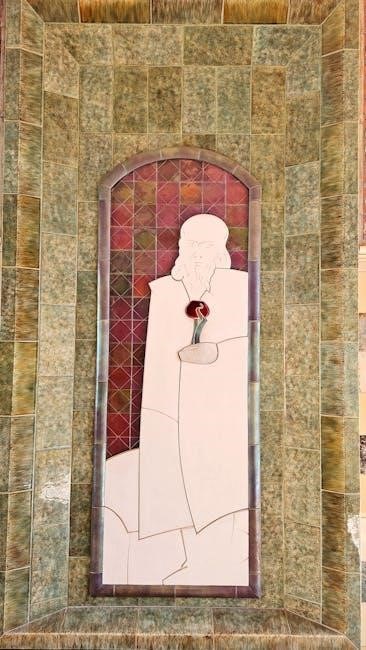Chrismon patterns are decorative and symbolic Christian designs, often used in worship and home decor, representing faith and spirituality through intricate art and meaningful motifs․
1․1․ What Are Chrismon Patterns?
Chrismon patterns are symbolic Christian designs that combine the Greek letters “X” and “P” (Chi and Rho) to represent “Christ․” They are often used in worship and decorative settings, incorporating religious motifs like crosses, fish, and lambs․ These patterns are typically intricate and visually striking, serving as tools for faith expression and education․ They are widely used in churches, homes, and religious events to create a spiritually meaningful environment․ Chrismon patterns are also available in PDF formats, making them accessible for download and use in various projects, such as crafts, decorations, and educational activities․ Their versatility and deep symbolism make them a popular choice for those seeking to connect with Christian traditions through art and design․
1․2․ The Significance of Chrismon Patterns in Christianity
Chrismon patterns hold profound spiritual significance in Christianity, symbolizing the life, teachings, and resurrection of Jesus Christ․ Each design element, such as the Chi-Rho symbol, the cross, and the Alpha and Omega, carries deep theological meaning․ These patterns are used to enhance worship spaces, creating a visually immersive experience that reflects faith and devotion․ They also serve as educational tools, helping to convey biblical stories and doctrines through art․ The use of Chrismon patterns in PDF formats has further expanded their accessibility, allowing individuals and communities to incorporate these meaningful designs into various aspects of religious life․ Their presence in churches and homes fosters a sense of connection to Christian heritage and strengthens spiritual practices․
Historical Background of Chrismon Patterns
Chrismon patterns trace their origins to early Christianity, where symbols like the Chi-Rho and cross were used to teach theological truths through art, evolving into worship tools․

2․1․ Origins of Chrismon Patterns
Chrismon patterns, short for “Christ monograms,” have their roots in early Christianity, where symbols like the Chi-Rho (☧) and the cross were central to faith expression․ These patterns were initially used to teach theological truths through visual art, making complex doctrines accessible to a broader audience․ The early church adopted such symbols to signify Christ’s presence and teachings, embedding them in worship spaces and religious artifacts․ Over time, these designs evolved into intricate patterns that combined multiple symbols, creating a visual language of faith․ The use of gold and white, traditional Chrismon colors, further emphasized their sacred nature․ This artistic tradition became a cornerstone of Christian worship, blending spirituality with creativity to convey the message of Christ․ The patterns have since been adapted across cultures, maintaining their original spiritual significance while embracing diverse designs and materials․
2․2․ Evolution of Chrismon Patterns Over Time
Chrismon patterns have undergone significant transformations since their inception, reflecting changing artistic styles and cultural influences․ In the Middle Ages, intricate stone carvings and stained glass depicted these symbols, emphasizing their sacred nature․ The Renaissance period introduced more elaborate designs, blending religious motifs with artistic flourishes․ By the 20th century, Chrismon patterns began to incorporate modern materials and techniques, making them more accessible for personal and communal use․ The advent of digital design tools and PDF templates has further revolutionized their creation, enabling widespread sharing and customization․ Despite these changes, the core spiritual significance of Chrismon patterns has remained intact, serving as a visual testament to Christian faith․ Their evolution highlights the adaptability of religious art while preserving its profound meaning across generations․

Symbolism in Chrismon Patterns
Chrismon patterns symbolize Christian faith through sacred motifs like crosses and fish, inspiring meditation and worship by representing spiritual truths and divine grace․

3․1․ Religious Symbols and Their Meanings
Chrismon patterns incorporate a variety of religious symbols, each carrying profound spiritual significance․ The cross, a central symbol, represents Christ’s sacrifice and resurrection․ The fish, or Ichthys, signifies Jesus as the “Son of God” and serves as an ancient Christian identifier․ The dove embodies the Holy Spirit, symbolizing peace and divine presence․ Alpha and Omega symbols denote God’s eternal nature․ These motifs, often intertwined in intricate designs, convey deep theological truths and inspire devotion․ They are not merely decorative but serve as visual reminders of Christian faith and teachings․ By understanding these symbols, believers can deepen their connection to their faith and enrich their worship experiences․ Chrismon patterns thus become a powerful tool for spiritual reflection and education․
3․2․ Use of Chrismon Patterns in Worship and Decor
Chrismon patterns are widely used in Christian worship and home decor to enhance spiritual environments․ In churches, they are often displayed on banners, altars, and windows to visually represent biblical themes and doctrines․ These patterns create a sacred atmosphere, drawing worshippers into deeper reflection and prayer․ At home, Chrismon patterns adorn walls, tabletops, and seasonal decorations, serving as reminders of faith․ Their intricate designs and symbolic motifs make them versatile for both traditional and contemporary settings․ By incorporating Chrismon patterns, individuals and congregations can visually celebrate their faith, making worship spaces more meaningful and inspiring personal devotion․ Their aesthetic appeal and spiritual significance make them a popular choice for enhancing both liturgical and domestic environments․

Types of Chrismon Patterns
Chrismon patterns come in traditional and modern designs, offering classic symbols like the cross and contemporary styles for diverse worship and decorative purposes․

4․1․ Traditional Chrismon Patterns
Traditional Chrismon patterns are timeless designs rooted in Christian symbolism, often featuring classic motifs like the cross, fish, and alpha/omega․ These patterns are deeply meaningful, representing core beliefs and spiritual themes․ They are frequently used in church decorations and home worship spaces to create a reverent atmosphere․ Traditional Chrismons often incorporate simple yet profound imagery, such as the Lamb of God or the crown of thorns, which hold significant religious importance․ These designs are typically rendered in muted colors like gold, white, and red, enhancing their sacred appeal․ Many traditional Chrismon patterns are handcrafted, preserving their artisanal heritage․ They serve as a connection to the past, reflecting the enduring legacy of Christian art and worship․ Their universal recognition makes them a popular choice for both religious and cultural celebrations․
4․2․ Modern and Innovative Designs
Modern Chrismon patterns blend traditional symbolism with contemporary aesthetics, offering fresh and creative interpretations of Christian motifs․ These designs often incorporate bold colors, abstract shapes, and minimalist styles, appealing to a wider audience․ Innovations include geometric patterns, 3D effects, and digital art, making Chrismons more versatile for various applications․ Many modern designs are inspired by cultural diversity, blending global influences with traditional Christian symbols․ This evolution ensures Chrismons remain relevant in today’s artistic and cultural landscape while maintaining their spiritual essence․ The use of new materials and techniques has also expanded their creative possibilities, allowing for intricate details and unique visual representations․ As a result, modern Chrismon patterns continue to inspire both artists and worshippers, bridging tradition and innovation seamlessly․ Their adaptability makes them a staple in modern worship spaces and personal devotional practices․

Creating Chrismon Patterns
Creating Chrismon patterns involves transforming simple materials into meaningful Christian art, inspiring faith and reflection through intricate designs and spiritual themes․
5․1․ Basic Materials and Tools Needed
To create Chrismon patterns, you’ll need a few simple materials and tools․ Start with high-quality paper or cardstock, along with scissors or a craft knife for cutting intricate designs; A pencil and ruler are essential for sketching and measuring․ Glue or adhesive tape will help assemble the patterns, while decorative items like beads, sequins, or gold leaf can add a touch of elegance․ For precision, consider using a cutting mat and craft scissors․ If designing digitally, a computer with graphic design software is necessary․ Print your designs on sturdy paper using a reliable printer․ Templates, often available in PDF formats, provide a great starting point for beginners․ These tools and materials will help you craft beautiful and meaningful Chrismon patterns for worship or home decor․
5․2․ Step-by-Step Guide to Making Chrismon Patterns
Creating Chrismon patterns involves a few simple steps․ Begin by selecting a design or template, which can often be found in PDF formats online․ Print the template on sturdy paper or cardstock․ Use scissors or a craft knife to carefully cut out the pattern, following the lines precisely․ For intricate designs, a cutting mat can help protect your workspace․ Once cut, decorate the pattern with beads, sequins, or other embellishments to add visual appeal․ If desired, assemble multiple patterns into a larger design using glue or adhesive tape․ Finally, apply a protective finish like varnish to preserve the design; Display your finished Chrismon pattern in a place of prominence, such as on a wall or in a window, to enjoy its beauty and symbolism․

Chrismon Patterns in PDF Format
Chrismon patterns in PDF format are widely available online․ They can be downloaded for free or purchased from various sources․ These PDFs usually include designs, templates, and guides for creating Chrismon ornaments or decorations․ They are popular because they offer a quick and easy way to access traditional and modern designs, suitable for both personal and community use․
6․1․ Benefits of Using PDF Templates
Using PDF templates for Chrismon patterns offers numerous advantages․ They provide high-quality, scalable designs that maintain resolution when enlarged or printed․ PDFs are universally accessible across devices, ensuring compatibility with various software; They are ideal for crafting because they are easy to download and print․ PDF templates often include multiple designs in one file, saving storage space and reducing clutter; They are cost-effective and convenient, as they can be reused multiple times․ Additionally, PDFs are sharable, making them perfect for group projects or community activities․ They also allow for customization, enabling users to adapt patterns to suit personal preferences․ Overall, PDF templates are a practical and efficient way to create Chrismon patterns while preserving their intricate details and religious significance․
6․2․ How to Download and Use Chrismon Patterns PDF
To download and use Chrismon patterns in PDF format, start by visiting reputable websites or craft stores offering religious templates․ Use the search bar to find “Chrismon patterns PDF” and select a design that suits your needs․ Ensure the file is free or purchasable, then download it to your device․ Once downloaded, open the PDF using a viewer like Adobe Acrobat․ Print the patterns on sturdy paper or cardstock for crafting․ Cut out the designs carefully with scissors or a craft knife․ Use these patterns to create ornaments, decorations, or worship aids․ Many PDFs are customizable, allowing you to resize or modify elements․ Save the file for future projects or share it with others for collaborative crafting․ This method ensures easy access to high-quality, reusable Chrismon designs for various religious and artistic purposes․

Popular Chrismon Patterns for Different Occasions
Chrismon patterns are widely used for Christmas, Easter, and other religious celebrations, featuring symbols like crosses, doves, and fishes, tailored to specific holy days and themes․
7․1․ Christmas and Easter Themes
Chrismon patterns for Christmas and Easter are among the most popular, expressing deep spiritual significance․ Christmas themes often feature the Chrismon tree, adorned with symbols like the cross, angel, and star, representing the birth of Jesus․ Easter themes emphasize resurrection, with motifs such as the empty cross, dove, and lily, symbolizing new life and hope․ These designs are frequently used in church decorations, worship materials, and personal crafts․ PDF templates for these themes are widely available, offering intricate and meaningful designs that can be easily downloaded and printed․ They provide a creative way to celebrate these holy days while reinforcing their religious importance․ The use of these patterns helps communities connect with the true meaning of the holidays through art and symbolism․
7․2․ Patterns for Other Religious Holidays
Chrismon patterns are not limited to Christmas and Easter; they are also used to celebrate other significant religious holidays․ Lent and Advent are prominent periods where these patterns are utilized, incorporating symbols that reflect the spiritual journey of these times․ For instance, Lent may feature motifs like the crown of thorns or the prayerful hands, while Advent might include designs symbolizing hope and anticipation․ Additionally, holidays such as Epiphany and Pentecost have their own unique Chrismon patterns—Epiphany often includes the star of Bethlehem or the three kings, and Pentecost features symbols like flames or doves representing the Holy Spirit․ PDF templates for these occasions provide accessible and creative ways to enhance worship spaces and personal devotionals, allowing individuals to easily download and use these meaningful designs;
Case Studies and Examples
Churches worldwide have utilized Chrismon patterns PDFs to unify their decorations, while schools incorporate them into religious craft projects, enhancing both community engagement and spiritual connection․
8․1․ Real-World Applications of Chrismon Patterns
Chrismon patterns have been widely adopted in various religious and educational settings․ Churches often use these designs to create meaningful ornaments for Advent wreaths or nativity scenes, fostering a sense of community and spiritual connection․ Schools incorporate Chrismon patterns into craft projects, teaching students about Christian symbolism while promoting creativity․ Additionally, these patterns are used in worship decor, such as banners or stained glass designs, enhancing the visual appeal of religious spaces․ The accessibility of Chrismon patterns in PDF format has made it easier for individuals and groups to download and print templates, enabling widespread use․ These applications highlight the practical and inspirational value of Chrismon patterns in both religious and cultural contexts, making them a versatile tool for faith-based activities and artistic expression․

8․2․ Inspiring Projects Using Chrismon Patterns
Chrismon patterns have inspired a variety of creative and meaningful projects, particularly when used in conjunction with PDF templates․ One popular project is the creation of themed wreaths for religious holidays, where intricate Chrismon designs are printed and assembled into beautiful, symbolic displays․ Another inspiring idea is the use of Chrismon patterns in stained glass art, where the templates guide the cutting and assembly of colorful glass pieces․ Additionally, many crafters use Chrismon PDFs to design custom ornaments, banners, and even quilts, blending traditional symbolism with modern artistic expression․ These projects not only showcase the versatility of Chrismon patterns but also serve as a way to share faith and creativity within communities, making them a beloved activity for individuals and groups alike․
Cultural and Artistic Impact
Chrismon patterns have significantly influenced religious art and culture, blending traditional Christian symbols with modern design trends․ Their timeless appeal inspires global artists and crafters, bridging faith and creativity․
9․1․ Chrismon Patterns in Art and Craft
Chrismon patterns have become a cornerstone in religious art and craft, offering a creative way to express faith through intricate designs․ These patterns, often shared in PDF formats, inspire artists to blend traditional Christian symbolism with modern crafting techniques․ From embroidery to woodworking, Chrismons are adaptable to various mediums, making them a popular choice for both traditional and contemporary art․ The use of Chrismon patterns in craft projects not only enhances the aesthetic appeal of religious spaces but also serves as a meaningful way to share the stories behind each symbol․ Their versatility and deep spiritual significance make them a cherished element in both personal and communal artistic expressions, fostering a connection between faith and creativity․
9․2․ Global Popularity and Adaptations
Chrismon patterns have gained widespread popularity worldwide, transcending cultural boundaries as a meaningful form of religious expression․ Their adaptability has led to diverse interpretations, blending traditional Christian symbols with local art styles․ In Asia, intricate paper cutouts are common, while African cultures incorporate vibrant textiles․ European and American artists often merge Chrismons with folk art traditions․ The availability of Chrismon patterns in PDF formats has further fueled their global adoption, allowing individuals to access and adapt these designs easily․ This cross-cultural adaptation has enriched Christian art, creating a shared visual language that unites believers across continents․ The fusion of traditional and modern techniques has made Chrismons a dynamic and evolving art form, reflecting the universal appeal of faith-inspired creativity․

No Responses